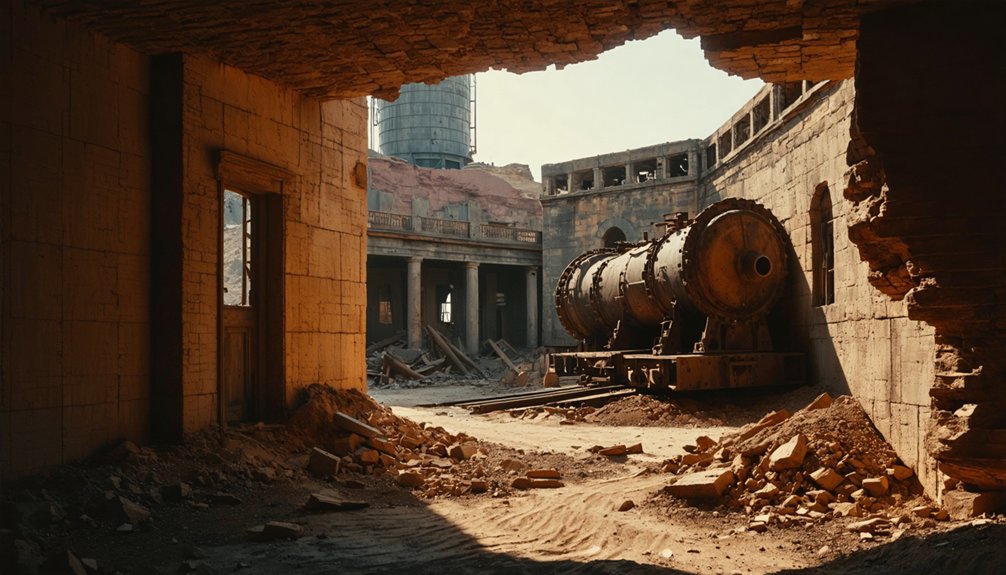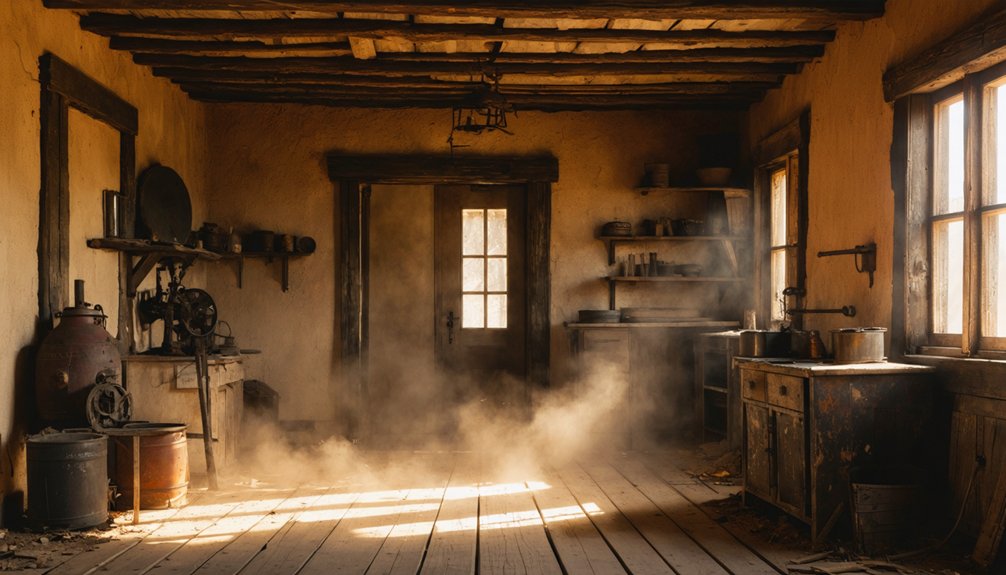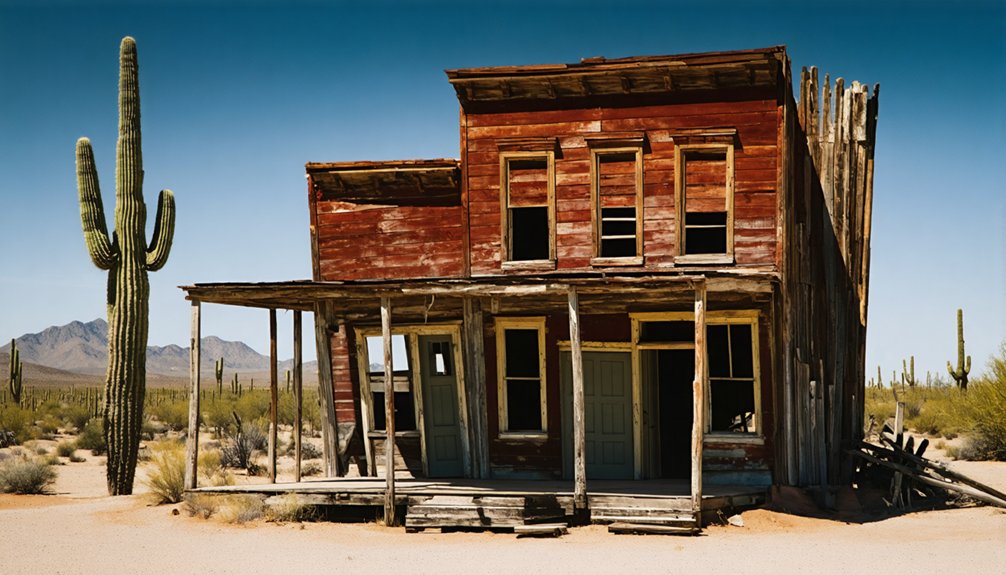Millville, Arizona was a short-lived silver milling town established in 1879 along the San Pedro River to process Tombstone’s silver ore. You’ll find its ruins within the San Pedro Riparian National Conservation Area, where industrial remnants like stamp mills and foundations still exist. Paired with neighboring Charleston, Millville enforced prohibition while generating millions in silver bullion until 1886 flooding and the 1887 earthquake led to its abandonment. These weathered stone walls reveal an untold frontier story.
Key Takeaways
- Millville was established in 1879 along the San Pedro River to process silver ore from Tombstone’s mines.
- The industrial town featured the Gird and Corbin Mills, producing over $90,000 in silver bullion during peak operations.
- Unlike neighboring Charleston with its vibrant social scene, Millville enforced alcohol prohibition to maintain worker discipline.
- Millville declined after 1886 flooding of Tombstone’s mines, with further destruction from the 1887 Sonoran earthquake.
- Now preserved within the San Pedro Riparian National Conservation Area, visitors can explore mill ruins and mining artifacts.
The Silver Boomtown on the San Pedro River
When Ed Schieffelin struck silver in Tombstone in 1878, he quickly recognized that processing the valuable ore would require a resource Tombstone sorely lacked: water.
Water became the precious missing ingredient in Tombstone’s silver equation—as valuable as the ore itself.
This water scarcity prompted Schieffelin, his brother Al, and business partner Richard Gird to establish Millville along the banks of the San Pedro River.
You can trace the town’s origins directly to Tombstone’s silver discovery and the practical need for a nearby milling operation.
The location was strategic—close enough to Tombstone for ore transportation yet situated where water was plentiful for processing.
Two essential operations, the Gird and Corbin Mills, were constructed to handle the growing demand for ore processing.
As part of Arizona Territory’s silver boom, Millville became an industrial hub that transformed raw ore into bullion worth millions.
The town embodied frontier industriousness, converting natural resources into wealth through innovation and determination.
Today, visitors can explore these historic remains within the San Pedro Riparian NCA, which preserves this important piece of Arizona’s mining heritage.
Industrial Heart of the Tombstone Mining District
Unlike Tombstone’s boisterous saloons and dusty streets, Millville emerged as the true industrial engine powering the entire mining district’s prosperity.
You’d have witnessed remarkable industrial innovation at the Gird and Corbin Mills, where gravity-fed stamp mills crushed 15-20 tons of ore daily, yielding over $90,000 in silver bullion during peak operations.
The economic rivalry between Millville and Charleston created distinct roles—Millville focused solely on production while Charleston became the social center.
Massive mule teams hauled 40-50 thousand pounds of ore daily across the desert to feed Millville’s insatiable mills.
These steam-powered operations, running continuously from 1879-1885, employed complex systems of rock breakers, stamp batteries, and mercury amalgamation, creating wealth that fueled regional development despite the health hazards workers faced. Richard Gird’s dam was crucial for providing the water necessary for the stamp milling process when surface water resources became increasingly scarce. Workers at these mills earned between $5 to $7 per day, significantly more than their mining counterparts.
Daily Life Between Millville and Charleston
Beyond the rhythmic pounding of Millville’s stamp mills and the clouds of industrial dust lay a tale of two interdependent frontier communities with sharply contrasting characters.
Had you lived in this area in 1880, your daily routines would have differed dramatically depending on which side of the San Pedro River you called home.
While Millville maintained Gird’s alcohol prohibition to guarantee worker discipline, just across the water, Charleston offered you four saloons, two Chinese laundries, and a brewery.
Community interactions centered around Charleston’s robust commercial infrastructure—five general stores, four restaurants, and various services—making it the residential and social heart with over 400 residents.
The town’s dual nature was exemplified by figures like Sam Aaron, who learned industrial skills at the mills but participated in Charleston’s gambling culture.
The Milling Process: From Ore to Silver Bars
The transformation of raw silver ore into gleaming bullion bars required a sophisticated industrial process that maximized efficiency through strategic placement and engineering.
When visiting Millville, you’d witness how gravity processing drove ore through multiple levels of treatment, from initial crushing to final refining. The mills served the Tombstone silver district, which produced approximately 32 million troy ounces of silver during the boom period. Mining innovations leveraged hillside topography to minimize energy consumption while stamp mill efficiency guaranteed continuous operation processing 15-20 tons daily. Modern operations like Super Champ employ similar principles with samples exceeding 1,000 ounces per ton of silver content.
Milling techniques involved four critical steps:
- Primary crushing by rock breakers to reduce ore to manageable pieces
- Pulverization into powder to increase ore composition surface area
- Chemical amalgamation where mercury bound with silver particles in slurry
- Retorting that separated precious metals from mercury through heating
Despite impressive productivity exceeding $1.3 million annually (1881-1882), these operations faced significant challenges in slurry management and mercury risks while balancing water needs with local ranchers’ rights.
Outlaws, Lawmen and Social Dynamics
While Millville’s neighboring settlement of Charleston earned a rowdier reputation for its saloons and gambling halls, you’ll find that Millville maintained stricter social order through prohibition policies within mill grounds.
You might be surprised to learn that the road connecting Millville to Tombstone became notorious for bandit attacks, with outlaws often hiding among the mesquite trenches to ambush silver shipments.
The Clanton gang and other border outlaws frequently traversed this corridor, creating constant tension between the law-abiding mill workers and the criminal elements that threatened their livelihoods. Ike Clanton’s involvement in cattle rustling operations across the U.S.-Mexico border made him particularly infamous in the region. This era of lawlessness reflected the larger struggle for law and order throughout late 19th-century Arizona, where cattle rustling and banditry were common occurrences.
Charleston’s Rowdier Reputation
Located just a few miles from the more famous Tombstone, Charleston earned a reputation as “tougher and livelier” than its neighboring silver boomtown, according to Eastern newspaper accounts.
You’d find Charleston’s outlaw culture thriving as notorious figures like Frank Stilwell, Johnny Ringo, and the Clanton Gang made it their refuge.
Despite the Tombstone Epitaph’s claims of a “well regulated” town, the reality included:
- Frank Stilwell paradoxically serving as both saloon owner and deputy sheriff
- The Clanton Ranch just five miles south becoming an outlaw sanctuary
- Saloon life centering around gambling, drinking, and frequent brawls
- Law enforcement consistently outmatched by the criminal element
With a population peaking around 400, Charleston maintained some community infrastructure—schools and telegraph—while simultaneously hosting confrontations between lawmen and outlaws that would cement its wild reputation. The town’s primarily adobe structures contrasted with neighboring Millville’s stone buildings, reflecting its hastier development and frontier character. The region experienced dramatic population growth when Tombstone expanded from merely 100 to 7,000 people following the discovery of silver.
Prohibition Within Mills
As John Vosburg established control over the Tombstone Mill and Mining Company‘s operations, he implemented a strict prohibition on alcohol within Millville’s boundaries—a decision that would profoundly shape the social landscape of the settlement.
You’d find Millville prohibition efforts were remarkably effective in maintaining worker discipline and creating an orderly industrial environment. This alcohol enforcement generated considerable discontent among mill workers, however, who increasingly crossed the San Pedro River to Charleston where drinking establishments welcomed them with open arms.
While you couldn’t find saloons on millsite property, just a short walk away existed a completely different social atmosphere. The contrast was striking—Millville remained comparatively quiet and industrious while neighboring Charleston developed a reputation for rowdiness and revelry.
This division created a distinctive social and economic symbiosis between the two settlements, each serving different aspects of frontier life.
Bandits Between Trenches
Beyond Millville’s orderly, alcohol-free industrial landscape lay a more dangerous reality—one defined by the ever-present threat of banditry and violence.
You’d have noticed the delicate balance between outlaws and lawmen, where the line between both roles often blurred. Stagecoaches traveling between Millville and Globe faced constant ambush risks from bandits exploiting the rugged terrain’s natural bandit hideouts.
Lawman tactics evolved from necessity—constables doubling as miners with limited resources employed sometimes extralegal measures to maintain order.
The social dynamics revealed a community divided in loyalties:
- Augustine Chacon’s notorious criminal exploits sparked both fear and admiration
- Vigilante groups formed among residents when official protection failed
- Outlaws gained support from locals who resented outside authority
- Commerce suffered under persistent threats, ultimately contributing to Millville’s abandonment
The Beginning of the End: Floods and Earthquakes

You’ll find Millville’s industrial decline began in 1886 when Tombstone’s silver mines flooded at 520 feet depth, forcing processing operations to relocate closer to the mines themselves.
The devastating Sonoran earthquake of May 3, 1887, measuring between 7.25 and 8.1 on the Richter scale, delivered the knockout blow by destroying nearly all structures in the region during its thirty-plus minutes of violent shaking and aftershocks.
These twin catastrophes—mine flooding that eliminated the mills’ purpose and seismic destruction that obliterated their physical infrastructure—created a cascading failure from which neither Millville nor nearby Charleston could recover.
Submerged Mining Operations
The devastating combination of natural disasters that struck Millville in the 1880s marked the beginning of the end for this once-thriving mining community.
When Tombstone’s silver mines flooded in 1886, submerged operations ceased completely, cutting off Millville’s lifeblood. This flooding represented a fatal blow to the economic ecosystem that had sustained the town.
You can trace Millville’s rapid decline to several key factors:
- Gird’s dam repeatedly failed during floods, disrupting water supply for essential mining techniques
- The 1887 Sonoran earthquake destroyed critical infrastructure and adobe buildings
- Technological advancements allowed for ore processing directly in Tombstone
- Water discovered beneath Tombstone eliminated the need for riverside mills
These converging disasters rendered Millville’s once-innovative milling operations obsolete, forcing investors and workers to abandon their dreams of silver prosperity.
1887 Earthquake Aftermath
When the massive Sonoran earthquake struck on May 3, 1887, Millville and neighboring Charleston faced catastrophic destruction that would seal their fate as ghost towns.
The 7.25-8.1 magnitude quake, centered just 40 miles south of the Mexican border, rendered both settlements uninhabitable as it demolished every adobe and wood-framed structure in its path.
You can imagine the devastating scene—aftershocks continuing for over thirty minutes while residents watched their community crumble.
This natural disaster couldn’t have come at a worse time, striking communities already weakened by the previous year’s mine flooding and the miners’ strike of 1885-1886.
The structural damage proved insurmountable, with Charleston’s post office officially closing by October 1888.
Within two years, both towns stood abandoned, their remains later dismantled for firewood by Mexican residents.
What Remains Today: Exploring the Ruins
Nestled along the San Pedro River approximately nine miles southwest of Tombstone, Millville’s deteriorating ruins offer a tangible connection to Arizona’s silver mining heyday.
The 1.8-mile discovery trail guides your ruins exploration past stone walls, adobe foundations, and the remnants of two major stamp mills—Gird and Corbin—where silver ore from Tombstone was once processed.
As you walk the easy 38-minute loop, you’ll encounter:
- Visible industrial components like rock breakers and stamp batteries
- Scattered metal debris from building materials and processing equipment
- Stone embankments gradually succumbing to erosion
- Remnants of residential structures including the Gird Residence
These historical artifacts paint a portrait of industrial ingenuity despite their deterioration from weathering, floods, and human scavenging for firewood and repurposing.
Preservation Efforts and Historical Significance

Since its designation as part of the San Pedro Riparian National Conservation Area in 1988, Millville’s historical legacy has been preserved through collaborative efforts between the Bureau of Land Management and volunteer organizations like Friends of the San Pedro River.
This ghost town preservation focuses on stabilizing the remaining stone embankments and adobe foundations that have withstood erosion, railroad construction impacts, and human dismantling.
The site’s historical significance extends beyond its physical remnants. As a critical industrial center processing Tombstone’s silver during the 1878-1886 boom, Millville represents the classic boom-bust cycle of frontier economics.
When you explore the 1.8-mile interpretive trail, you’ll witness how this once-thriving economic hub connects to the broader narrative of Arizona’s Wild West mining history.
Frequently Asked Questions
Were Any Significant Artifacts Recovered From Millville’s Ruins?
No significant artifacts have been formally documented from Millville. Archaeological findings focus primarily on structural remains rather than recovered objects, with petroglyphs nearby providing the most notable artifact significance.
Did Any Famous Historical Figures Visit Millville During Its Heyday?
While 400+ residents supported Millville’s peak activity, historical records don’t confirm famous visitors specifically. Frank Stillwell owned a Charleston saloon, and Curly Bill’s gang reportedly visited the area’s church in 1881.
What Indigenous Tribes Inhabited the Area Before Millville’s Establishment?
Before Millville’s establishment, you’d find Apache tribes occupying the area, with historical evidence of Mogollon and Salado cultures previously inhabiting the region. This indigenous history represents significant tribal significance spanning millennia.
How Did Women Contribute to Millville and Charleston’s Communities?
Wilful women wielded wonderful influence through domestic management, economic participation, and cultural leadership. You’ll notice their essential community support roles extended from household economies to establishing churches, organizing events, and ensuring stability during decline.
Are There Any Reported Hauntings or Paranormal Activity in Millville?
No documented ghost sightings exist specifically for Millville. You’ll find paranormal investigations focus instead on nearby Tombstone. Any claims about Millville hauntings remain anecdotal without substantial verification in historical records.
References
- http://www.ghosttownaz.info/millville-ghost-town.php
- https://www.destination4x4.com/millville-arizona-cochse-county-ghost-town/
- https://www.archaeologysouthwest.org/explore/charleston-and-millville-sites/
- https://naturalatlas.com/ghost-towns/millville-historic-townsite-2089786
- https://www.wyattearpexplorers.com/-charleston–millville-at.html
- https://www.gvrhc.org/Library/Charleston&Millville.pdf
- https://southernarizonaguide.com/exploring-millville-ruins-fspr/
- https://pinintheatlas.com/travel-blogs/ghost-towns/
- https://en.wikipedia.org/wiki/Silver_mining_in_Arizona
- https://westernmininghistory.com/towns/arizona/charleston/



